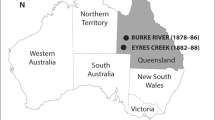Abstract
The Battle of Big Hole took place in western Montana on August 9–10, 1877, between the US 7th Infantry and the Nez Perce Indians. Big Hole was a short but very deadly battle (28 dead from an Army force of less than 200 and 60–90 Nez Perce killed) but provides an outstanding historical record. Eyewitness accounts from both sides, as well as oral traditions passed down to descendants, provide a detailed description of the battle. Archaeology surveys in the early 1990s recovered artifacts (primarily bullets and shell casings) and allow identification of individual weapons used by both sides. The original archaeological work used a computer-aided design (CAD) program. Reanalysis of the archaeological survey provides several new perspectives on the battle. The archaeological record shows a series of Army bullets moving up the slope to the location in historical records of a Nez Perce sniper firing on the Army troops. A weapons fan drawn from the sniper location shows where the Army anti-sniper fire could have originated and suggests where those soldiers fired from and which weapons they likely used. A weapons fan from the location of an ineffective Army mountain howitzer shows that it was poorly positioned to hit the Nez Perce village and that it also had extremely limited visibility to its flanks and rear, helping explain why it was captured so easily. The GIS can animate the locations of the individual weapons identified by shell casings, helping to trace the movement of troops during the initial attack on the Indian village and then the retreat to a fortified area. This study verifies a strong link among historical records, battlefield archaeology, GIS, and military terrain analysis.
Access this chapter
Tax calculation will be finalised at checkout
Purchases are for personal use only
Similar content being viewed by others
References
Brown, B. (2005). fGIS Program and help file: University of Wisconsin and Wisconsin Department of Natural Resources, available at http://www.forestpal.com/fgis.html. Last accessed 18 June 2019, but program has not been updated since 2005.
ESRI. (1998). ESRI shapefile technical description: ESRI White paper. Available online at http://www.esri.com/library/whitepapers/pdfs/shapefile.pdf. Last accessed 18 June 2019.
Fox, R. A., Jr. (2003). Archaeology, history, and Custer’s last battle: The Little Big Horn reexamined. Norman: University of Oklahoma Press.
Gibbon, J. (1860). The artillerist’s manual, compiled from various sources, and adapted to the service of the United States. New York: D.Van Nostrand.
Greene, J. A. (2000). Nez Perce summer 1877: The U.S. Army and the Nee-Me-Poo crisis. Helena: Montana Historical Society Press.
Guth, P. L. (1995). Slope and aspect calculations on gridded digital elevation models: Examples from a geomorphometric toolbox for personal computers. Zeitschrift für Geomorphologie N.F. Supplementband, 101, 31–52.
Guth, P. L. (2009). Geomorphometry in MICRODEM. In T. Hengl & H. I. Reuter (Eds.), Geomorphometry: Concepts, software, applications. Developments in soil science series (pp. 351–366). Amsterdam, Elsevier.
Haines, A. L. (1999). An elusive victory: The battle of the Big Hole. Helena: Falcon Publishing.
National Park Service. (2016). Big Hole, https://www.nps.gov/biho/planyourvisit/upload/FINAL-VERSION_-BIHO-unigrid_Side-2_X3_-compressed-for-web.pdf. Last accessed 18 June 2019.
Scott, D. D. (1994). A sharp little affair: The archeology of the Big Hole Battlefield. Reprints in Anthropology. Lincoln: J & L Reprint Company.
Scott, D. D., Fox, R. A., Jr., Connor, M. A., & Harmon, D. (2000). Archaeological perspectives on the battle of Little Bighorn (New ed.). Norman: University of Oklahoma Press.
Wikipedia. (2019). Big Hole National Battlefield, https://en.wikipedia.org/wiki/Big_Hole_National_Battlefield. Last accessed 19 June 2019.
Author information
Authors and Affiliations
Corresponding author
Editor information
Editors and Affiliations
Rights and permissions
Copyright information
© 2020 Springer Nature Switzerland AG
About this paper
Cite this paper
Guth, P.L., Scott, D.D. (2020). The Battle of Big Hole (Montana, USA, 1877): History, Archaeology, GIS, and Military Terrain Analysis. In: Guth, P. (eds) Military Geoscience. Advances in Military Geosciences. Springer, Cham. https://doi.org/10.1007/978-3-030-32173-4_3
Download citation
DOI: https://doi.org/10.1007/978-3-030-32173-4_3
Published:
Publisher Name: Springer, Cham
Print ISBN: 978-3-030-32172-7
Online ISBN: 978-3-030-32173-4
eBook Packages: Earth and Environmental ScienceEarth and Environmental Science (R0)




